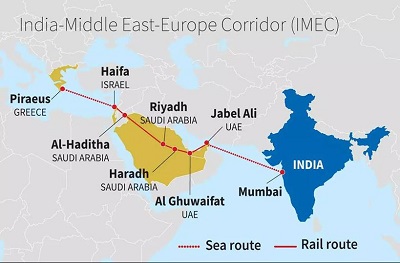Context-
The recent geopolitical events, particularly the Gaza war, have exposed strategic and logistical challenges facing the India-Middle East-Europe Corridor (IMEC). The signing of a significant bilateral contract between India and Iran for the operation of Chabahar Port on May 13, 2024, highlights India's commitment to enhancing connectivity with Afghanistan and Central Asia. However, the Gaza war has revealed critical vulnerabilities and missing links in the IMEC project.
The Strategic Importance of Chabahar Port
On May 13, 2024, India and Iran signed a 10-year bilateral contract for the operation of Chabahar Port. The agreement, facilitated by India’s Ports, Shipping and Waterways Minister Sarbananda Sonowal, is crucial not just as a bridge linking India with Iran, but also as a vital economic route connecting India with Afghanistan and Central Asian countries. This development is part of India's broader strategy to enhance regional connectivity and economic integration.
IMEC: A Counter to China's Belt and Road Initiative
The India-Middle East-Europe Corridor (IMEC) was launched on September 9, 2023, during the G-20 summit in New Delhi. It involves the European Union, France, Germany, India, Italy, Saudi Arabia, the United Arab Emirates (UAE), and the United States. Developed under the Partnership for Global Infrastructure and Investment (PGII), IMEC aims to boost economic development by enhancing connectivity between Asia, the Arabian Gulf, and Europe. The project is seen as a strategic counter to China’s Belt and Road Initiative (BRI).
● Structure and Objectives of IMEC: IMEC comprises two separate corridors: an east corridor connecting India to the Arabian Gulf, and a northern corridor linking the Arabian Gulf to Europe. The corridor integrates existing maritime and road transport routes with a new railway network designed to provide a reliable and cost-effective ship-to-rail transit network for goods and services. Additionally, it includes plans for laying cables for electricity and digital connectivity, as well as pipelines for clean hydrogen export.
● Key Ports and Routes: The IMEC corridor involves significant maritime and rail links:
○ Indian Ports: Kandla, Mumbai, and Mundra
○ UAE Ports: Fujairah, Jebel Ali, and Abu Dhabi
○ Saudi Arabia and Jordan: Rail-road link to the Mediterranean
○ European Ports: Haifa in Israel, Marseille in France, Messina in Italy, and Piraeus in Greece
This 4,800-kilometre-long corridor aims to secure regional supply chains, increase trade accessibility, and improve trade facilitation, potentially reducing the time and cost of transporting goods from India to Europe by 40% and 30%, respectively.
The Impact of the Gaza War
The Gaza war, which began on October 7, 2023, less than a month after the IMEC announcement, has significantly affected the project’s progress. The conflict has highlighted the vulnerabilities and missing links in the IMEC, posing serious challenges to its implementation.
● Disruptions and Threats
The war in Gaza has disrupted trade routes and exposed several strategic weaknesses:
○ Houthi Interference: Houthis in Yemen have blocked ships from Israel and its allies from accessing the Red Sea, forcing them to take longer routes around the Cape of Good Hope, thereby increasing shipping time and insurance costs.
○ Strait of Hormuz: Iran’s repeated threats to close the Strait of Hormuz, a critical chokepoint for global crude oil and natural gas shipments, pose significant risks. Similar threats and actions were witnessed during the Persian Gulf Crisis in 2019.
○ Impact on Israeli Ports: Israel's major ports, Eilat and Haifa, have suffered heavy losses due to disruptions in trade through the Red Sea and attacks by Hamas and its allies. The Adani Group-led consortium's purchase of Haifa port in January 2023 has been impacted, with expansion plans put on hold due to the ongoing conflict.
Addressing the Missing Links in IMEC
To mitigate the risks highlighted by the Gaza war, alternative routes and partnerships need to be considered to ensure the stability and success of the IMEC project.
● Oman: A Strategic Partner: Oman provides a strategic alternative to the ports in the UAE, which are vulnerable due to their location within the Persian Gulf. Omani ports, opening into the Arabian Sea, are well away from direct Iranian threats and offer a closer, direct link to Indian ports. Historically, Oman has been a gateway for Indian trade to West Asia, and politically, it maintains good relations with all regional stakeholders, including Israel.
● Egypt: A Western Spur: To the west, an alternative route through Egypt could provide a safer and more reliable connection to European ports. Egypt's Mediterranean ports offer direct sea routes to Europe, bypassing the volatile regions. Including Egypt in the IMEC project could balance regional dynamics, given Egypt's strong relationships with regional players and its expressed interest in participating in the corridor.
Conclusion
The IMEC is a forward-looking and transformative initiative, designed to enhance regional connectivity and economic integration while countering China’s BRI. However, the Gaza war has exposed significant vulnerabilities and missing links in the current structure of the IMEC. By incorporating strategic partners like Oman and Egypt, the corridor can be insulated from future conflicts and disruptions, ensuring its long-term viability and success. These adjustments will not only address the geopolitical risks but also strengthen the economic and political ties among the participating nations, contributing to a more stable and prosperous region.
|
Probable Questions for UPSC Mains Exam-
|
Source- The Hindu









